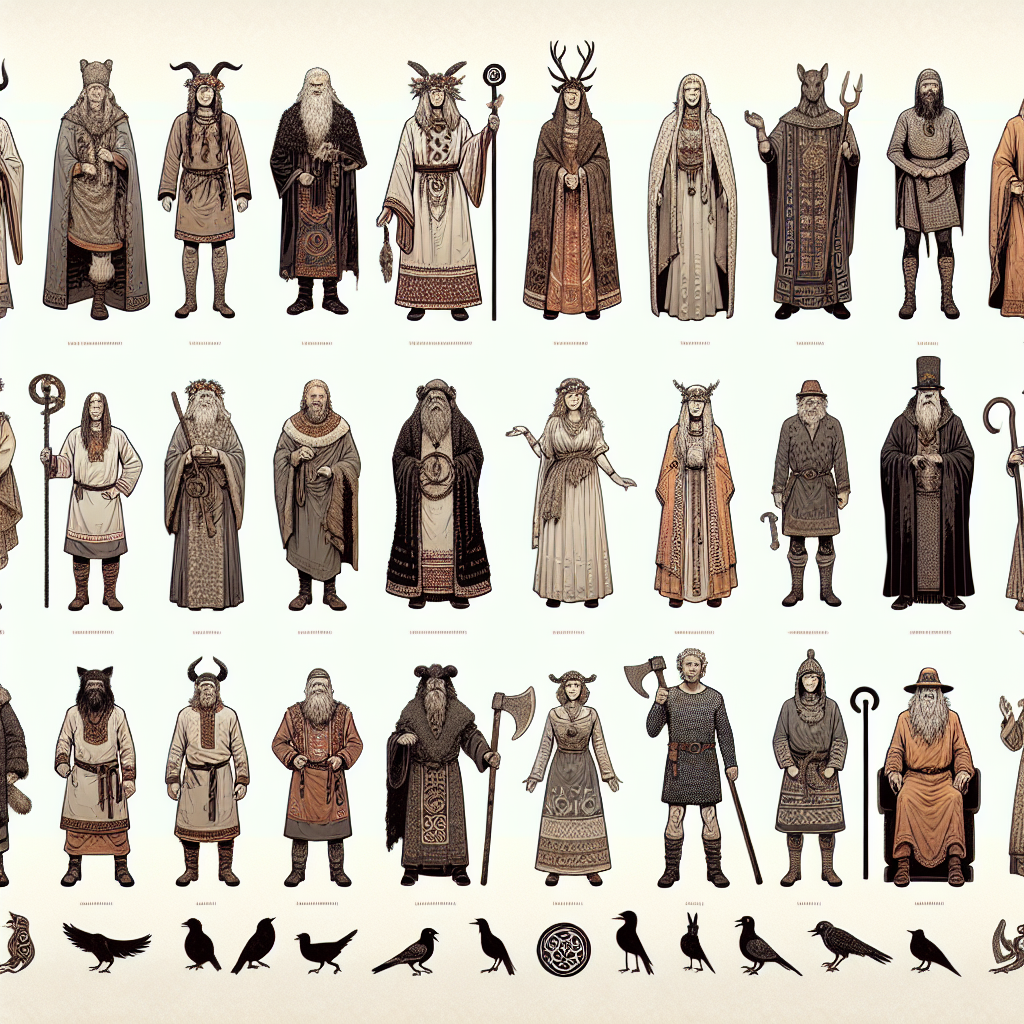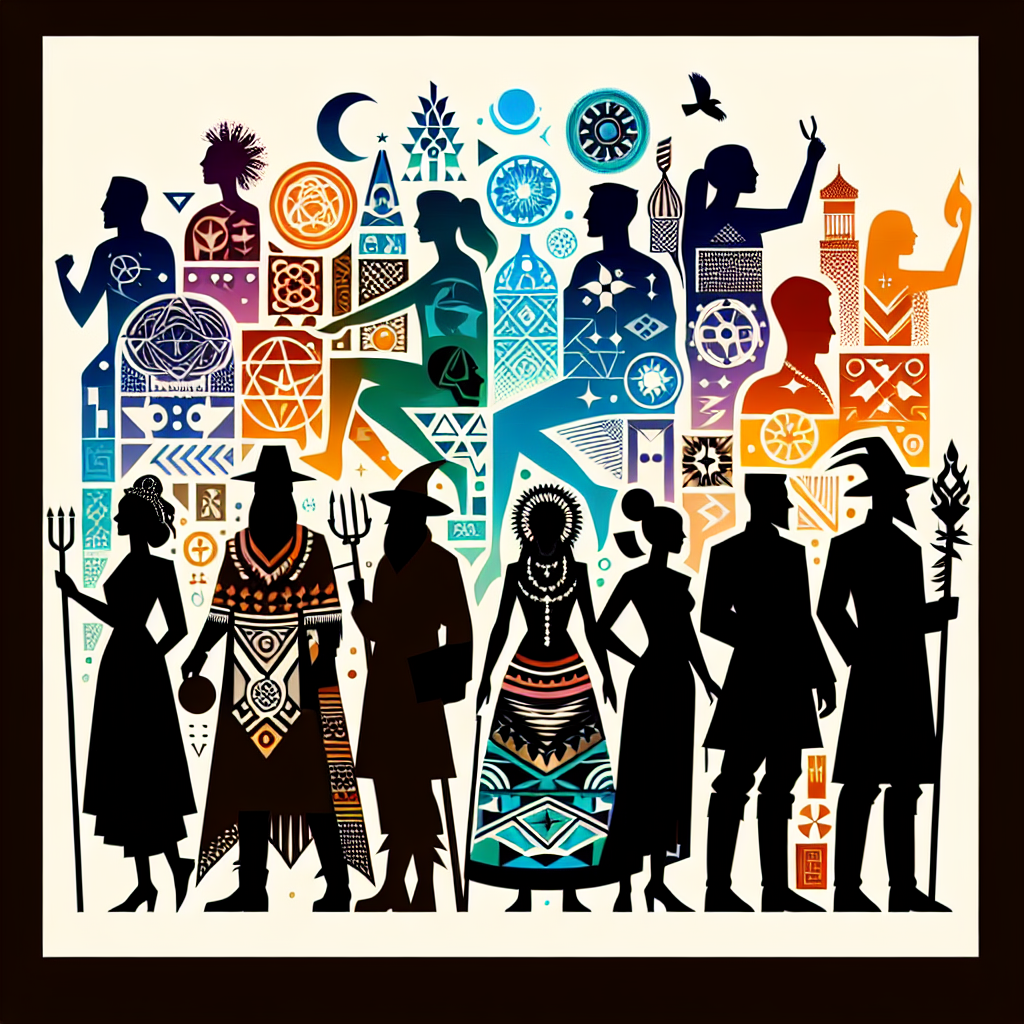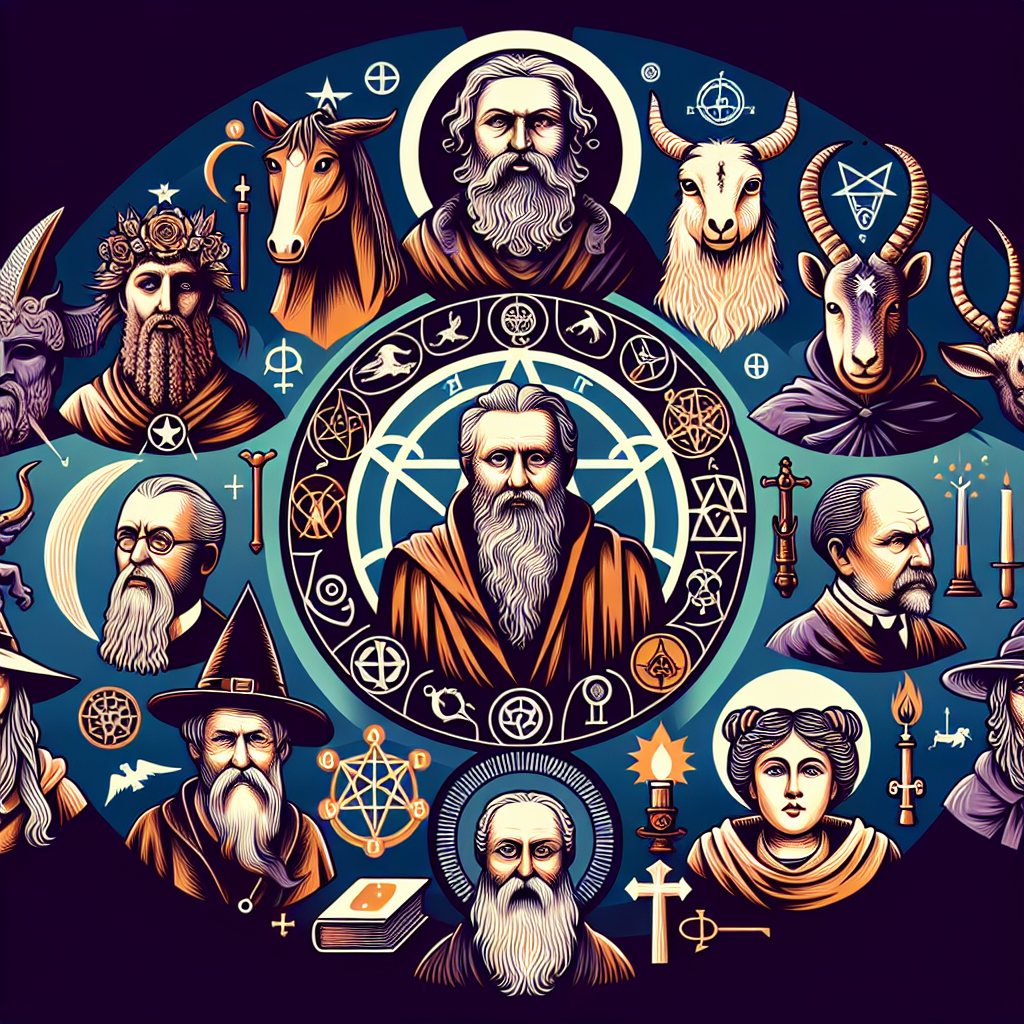As an Amazon Associate I earn from qualifying purchases.

u003cH2u003e18 Notable Pagans Who Shaped Modern Practicesu003c/H2u003e
Pagans have long influenced contemporary spiritual and cultural practices, adding layers of meaning and tradition that continue to resonate today. The term “Pagan” originally referred to rural villagers, but over the centuries, it has become an umbrella term encompassing a variety of earth-centered religions. Paganism is one of the fastest-growing spiritual movements in the West, with an estimated 1.5 million adherents in the United States alone.
Current pagan practices often blend ancient customs with modern interpretations, carving out a vibrant tapestry of rituals and beliefs. These practices are deeply embedded in many aspects of modern life, including environmentalism, feminism, and alternative medicine. One compelling statistic shows that over 60% of modern Pagans practice some form of eco-spirituality, emphasizing a deep connection with nature and the Earth.
u003cH3u003eHistorical Figuresu003c/H3u003e
One of the most influential historical figures in Paganism is Aleister Crowley, a British occultist whose writings formed the backbone of Thelema, a philosophical and spiritual system that emphasizes “Do what thou wilt.” Crowley's philosophy has permeated various aspects of modern Pagan practices, including ceremonial magic and Wicca. Another critical figure is Gerald Gardner, often referred to as the father of modern Wicca. Gardner's rituals, writings, and public advocacy in the mid-20th century played a monumental role in shaping contemporary Pagan practices.
Doreen Valiente, often considered the mother of modern Witchcraft, worked alongside Gardner and contributed significantly to the Book of Shadows, a foundational Wiccan text. Her poetic invocations and rituals continue to be used by modern Wiccans today. Additionally, Robert Cochrane, a significant figure in the Traditional Witchcraft movement in the 1960s, introduced more mystical and folklore-based elements, influencing non-Wiccan strains of Paganism.
u003cH3u003eModern Innovatorsu003c/H3u003e
Starhawk, a contemporary Pagan author and activist, has also left an indelible mark on modern Paganism and ecofeminism. Her book, “The Spiral Dance,” published in 1979, has been widely influential in both Pagan circles and the broader feminist movement. Starhawk's work emphasizes the interconnectedness of all things, advocating for social justice and environmental sustainability.
Raymond Buckland, another prominent figure, brought Gardnerian Wicca to the United States and later developed Seax-Wica, a tradition that allows for more personal interpretations of Wiccan rituals. His comprehensive guidebooks have educated generations of new Pagans. Margot Adler, a journalist turned leading Pagan author, provided an accessible and scholarly overview of modern Paganism in her book “Drawing Down the Moon,” making Pagan traditions more understandable to the general public.
u003cH3u003eCultural Impactu003c/H3u003e
Modern Pagan practices have also been shaped by artists and musicians. For example, the iconic music of Stevie Nicks, often referred to as the “White Witch,” has woven mystical and Pagan themes into mainstream culture. Similarly, the band Inkubus Sukkubus has integrated Gothic Paganism into the music scene, bringing esoteric themes to a broader audience.
In the realm of digital media, figures like Jason Pitzl-Waters have expanded Pagan communities through platforms like “The Wild Hunt,” an online news journal for Pagan-oriented news. These modern innovators have contributed to the normalization and acceptance of Paganism in mainstream society, allowing for a more comprehensive understanding of these diverse spiritual practices.
Aleister Crowley, often dubbed “The Great Beast 666,” is one of the most influential pagans to have ever existed. He founded the religion of Thelema, and his extensive writings have influenced modern witchcraft and ceremonial magic. Crowley's focus on personal freedom and occult practices laid the groundwork for various neopagan movements.
Next, Gerald Gardner, the father of modern Wicca, revitalized pagan traditions in the mid-20th century. Gardner's initiation into witchcraft and subsequent writings, such as “Witchcraft Today” and “The Meaning of Witchcraft,” provided a foundation for contemporary Wicca, emphasizing rituals, a respect for nature, and the worship of a Goddess and God.
Doreen Valiente worked closely with Gardner and made significant contributions to Wiccan liturgy. Known as the “Mother of Modern Witchcraft,” Valiente’s poetry and rituals, such as the “Charge of the Goddess,” are staples in Wiccan practice today. Her efforts helped solidify modern Wicca's structure and beliefs.
Raymond Buckland, a student of Gardner, brought Wicca to the United States and founded Seax-Wica. He authored “Buckland's Complete Book of Witchcraft,” an essential guide for many aspiring witches, effectively broadening Wiccan practices in North America.
Starhawk, a renowned author and activist, added a feminist and ecological dimension to neopaganism. Her book, “The Spiral Dance,” published in 1979, is a seminal text in feminist spirituality and has inspired countless modern pagans to incorporate eco-conscious and feminist principles into their practices.
Margot Adler, a journalist and Wiccan priestess, authored “Drawing Down the Moon,” a highly influential ethnographic study of contemporary paganism in the United States. Her work provided an in-depth look at the diversity and richness of pagan practices and communities across the country.
Selena Fox, the founder of Circle Sanctuary, has been a pivotal figure in promoting pagan rights and environmental activism. Through her organization, she has fostered a sense of community among pagans and advocated for religious freedom.
Friedrich Nietzsche, though not a pagan in the traditional sense, influenced modern pagan metaphysics with his philosophy. His ideas about the “Übermensch” and the revaluation of values resonated with many neopagans searching for a worldview that emphasizes individualism and a return to pre-Christian values.
James Frazer's “The Golden Bough,” a comprehensive study on mythology and religion, significantly impacted modern pagan practices. His exploration of ancient rituals provided a historical context that modern pagans often draw upon to revive and reinterpret ancient traditions.
Robert Graves' book, “The White Goddess,” examined the role of goddess worship in ancient cultures and has inspired many neopagans to honor female deities. Graves' poetic approach blended scholarship and myth, offering a compelling vision of the divine feminine.
Carl Jung's exploration of archetypes and the collective unconscious contributed to pagan psycho-spiritual practices. His work on myth, symbolism, and the inner self has been integral to understanding pagan spiritual experiences and rituals.
Joseph Campbell, a scholar of comparative mythology, has influenced countless pagans with his book “The Hero with a Thousand Faces.” Campbell's exploration of the Hero's Journey has provided a framework for understanding mythological motifs and their relevance to personal spiritual growth.
Scott Cunningham, a prolific writer on Wicca and natural magic, authored practical guides like “Wicca: A Guide for the Solitary Practitioner,” helping solitary pagans develop personal spiritual practices without needing a coven.
Z. Budapest, a feminist witch and author, founded the Dianic Tradition of Wicca, focusing exclusively on the worship of the Goddess and empowering women within pagan practices. Her work, including “The Holy Book of Women's Mysteries,” has been foundational for feminist paganism.
Isaac Bonewits, a prominent pagan author and founder of Ár nDraíocht Féin (ADF), worked to reconstruct and modernize Druidic practices. His book, “Real Magic,” explored the theory and practice of magic, providing invaluable insights for modern pagans.
Caitlín and John Matthews, leading figures in Celtic spirituality, have authored numerous books on Celtic mythology and shamanism. Their work has greatly influenced modern pagans who seek to reconnect with Celtic deities and customs.
Miriam Simos, better known as Starhawk, is a leading voice in eco-paganism and social activism. Her integration of permaculture and spirituality in “The Earth Path” and her significant involvement in global activist movements have inspired a holistic approach to modern paganism.
In the United States, approximately 1 to 1.5 million people identify as pagans or adhere to some form of neopaganism.
Gerald Gardner: Reviving Witchcraft
My curiosity led me to the works of Gerald Gardner, often regarded as the father of modern Wicca. When I first started exploring paganism, Gardner's writings were the key that unlocked a trove of ancient wisdom repackaged for contemporary seekers. I remember my first reading of his book “Witchcraft Today.” It felt like a revelation, that someone in the 20th century was legitimizing practices that resonated with my spiritual inclinations.
Later on, I joined a local Wiccan coven that followed Gardnerian traditions. Our rituals were heavily influenced by his teachings, complete with the ceremonial tools and ritual structures he described. These experiences grounded me in the notion that ancient wisdom could be melded with modern practices in meaningful ways.
My understanding of nature and its cycles deepened through this practice. Gardner’s emphasis on the seasonal festivals and the role of the natural elements transformed my appreciation of the environment. It wasn’t just about personal or spiritual growth; it was about acknowledging the interconnectedness of all life. His ability to create a structured yet deeply personal path continues to shape my spiritual journey.
Doreen Valiente: The Mother of Modern Witchcraft
While Gerald Gardner laid the foundation, it was Doreen Valiente who brought a lyrical beauty to the rituals and practices. Her work transformed standard incantations into poetic invocations that stirred the soul. The first time I chanted one of her compositions during a full moon ritual, the words seemed to dance with the energy of the evening, making the experience even more enchanted.
Valiente’s contributions also taught me the value of intuition in practice. Her insistence on the importance of personal connection to the rites and rituals was liberating. It wasn’t just about following a prescribed set of actions but feeling them deeply and letting them resonate on a personal level. This approach has always motivated me to tailor rituals in ways that feel most meaningful to me.
The books she left behind, especially “Witchcraft for Tomorrow,” became my go-to guides. They offered not only historical context but also practical advice on crafting ceremonies that felt both ancient and contemporary. Her literary touch added layers to my understanding of pagan rituals, creating a richer, more immersive experience every time I stepped into the sacred circle.
Alejandro Jodorowsky: Mysticism and Film
Discovering Alejandro Jodorowsky’s work felt like finding a hidden treasure chest. His films like “The Holy Mountain” and “El Topo” brought a surreal, mystical lens to the exploration of spiritual themes. Watching these movies was a transformative experience for me, akin to participating in a visual ritual that opened my mind to unconventional forms of spiritual storytelling.
Jodorowsky’s unique approach combined elements of Tarot, surrealism, and ritualistic symbolism, making me realize that spiritual practice doesn’t have to fit into a rigid mold. It could be as fluid as the visual narratives he so expertly crafted. This understanding broadened my view of what it means to engage in a spiritual journey, allowing for more creative and individualized expressions.
His work didn’t just influence my spiritual practices within paganism; it also affected my artistic endeavors. Encouraged by his example, I began incorporating mystical symbols and themes into my own art and writing. This synergistic blend of creativity and spirituality has since become a cornerstone of my personal practice, resonating deeply with my quest for a holistic form of expression.
Starhawk: Activism and Earth-Based Spirituality
Starhawk’s “The Spiral Dance” was a pivotal read for me. Her integration of activism and earth-based spirituality resonated deeply, inspiring me to view my pagan practice not just as a personal journey but as a platform for broader social change. Her ideas about ecological balance and social justice fit seamlessly into my spiritual framework, adding another layer of purpose to my practices.
Attending one of her workshops was a memorable experience. It was eye-opening to see how she facilitated group rituals that not only connected people spiritually but also politically. Her practical methodologies allowed me to explore the intersections of magic, community, and activism. It wasn’t just about casting spells or invoking deities; it was about creating tangible change in the world around me.
Her influence encouraged me to participate in more community-focused activities. I found myself drawn to ecological activism, volunteering for local environmental initiatives. Using the skills and rituals I learned, I’ve organized multiple community gatherings centered on earth healing and conservation. Starhawk showed me that spirituality could be a powerful tool for fostering community and activism, enriching my pagan practice in unexpected and fulfilling ways.
1. Who were some of the most influential pagans mentioned in the article?
The article highlights figures such as Gerald Gardner, Doreen Valiente, Aleister Crowley, and Starhawk as some of the most influential individuals who have significantly shaped modern pagan practices.
2. What contributions did Gerald Gardner make to modern paganism?
Gerald Gardner is considered the father of modern Wicca. He published influential works on witchcraft in the mid-20th century and is credited with formalizing many of the practices and traditions that are central to contemporary Wiccan practices.
3. How did Doreen Valiente impact modern pagan practices?
Doreen Valiente is often referred to as the mother of modern witchcraft. She worked closely with Gerald Gardner and contributed significantly to the Wiccan liturgy and rituals, helping to shape the religion into what it is today.
4. What role did Aleister Crowley play in the development of modern paganism?
Aleister Crowley was a prolific writer and occultist who founded the religion of Thelema. His works and rituals have had a lasting influence on various modern pagan and occult traditions, including Wicca and Chaos Magick.
5. Who is Starhawk and what is her influence on modern paganism?
Starhawk is a contemporary pagan author and activist known for her works on ecofeminism and earth-based spirituality. Her book “The Spiral Dance” is considered a seminal work in modern paganism, promoting the Goddess movement and linking spirituality with environmentalism.
6. Are there any notable pagan authors that have contributed to modern literature on paganism?
Yes, notable pagan authors include Scott Cunningham, who wrote extensively on Wicca and natural magic, Raymond Buckland, and Margot Adler, whose works have been instrumental in making paganism more accessible to the general public.
7. How has modern paganism evolved from ancient pagan practices?
Modern paganism has evolved by reviving and adapting ancient practices, beliefs, and rituals for contemporary contexts. It often incorporates influences from various ancient pagan traditions, such as Celtic, Norse, and Greco-Roman polytheism, while also incorporating modern values like environmentalism, feminism, and social justice.
8. What distinguishes modern paganism from other religious practices?
Modern paganism is often distinguished by its polytheistic beliefs, reverence for nature, and practice of rituals and magic. Unlike many mainstream religions, modern paganism is typically decentralized, with a focus on personal spirituality and individual experience.
9. Can anyone become a modern pagan, or are there specific requirements or initiations?
Anyone can become a modern pagan as there are no universal requirements or formal initiations. Some traditions, like Wicca, may have initiation rituals, but many modern pagans practice independently or join groups that emphasize personal experience and self-discovery.
10. How have modern pagan practices influenced popular culture?
Modern pagan practices have influenced popular culture in various ways, including through literature, film, and art. Themes of witchcraft, magic, and nature worship can be seen in popular books like the “Harry Potter” series, movies like “The Craft,” and TV shows like “Charmed” and “American Horror Story: Coven.

Conclusion
Throughout history, a host of notable pagans have substantially shaped modern practices, each contributing uniquely to the contemporary landscape of paganism. Historical figures like Hypatia and Giordano Bruno championed the fusion of pagan thought with scientific inquiry and philosophical exploration, challenging the dominant religious ideologies of their times. Similarly, folklorist Charles Leland and influential author Aleister Crowley infused modern paganism with rich, eclectic traditions and esoteric wisdom, bridging ancient practices with contemporary spiritual needs. Figures like Gerald Gardner and Doreen Valiente laid the foundational stones for Wicca, one of the most recognizable branches of modern paganism, synthesizing ceremonial magic, folklore, and nature reverence into a cohesive and influential spiritual path.
The impact of these pagan pioneers extends beyond individual practices, inspiring current generations to explore and adapt various aspects of pagan beliefs into their spiritual and daily lives. Notable modern figures, including Starhawk and Margot Adler, have integrated feminist and ecological perspectives into paganism, emphasizing the importance of balance, sustainability, and the celebration of life cycles. This ongoing evolution reflects the dynamic and inclusive nature of modern paganism, which continues to honor diversity while fostering a sense of community and spiritual growth. Ultimately, the contributions of these influential pagans underscore the enduring relevance and adaptability of pagan traditions, ensuring their continued evolution and prominence in today’s spiritual landscape.
Amazon and the Amazon logo are trademarks of Amazon.com, Inc, or its affiliates.


